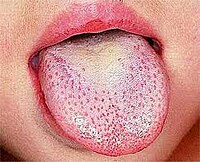
Photo from wikipedia
Objective To determine the incidence and clinical predictors of invasive bacterial infection (IBI) in well-appearing children who present to the emergency department (ED) with fever and petechiae. Design A prospective,… Click to show full abstract
Objective To determine the incidence and clinical predictors of invasive bacterial infection (IBI) in well-appearing children who present to the emergency department (ED) with fever and petechiae. Design A prospective, observational, multicentre study was conducted in 18 hospitals between November 2017 and October 2019. Patients A total of 688 patients were recruited. Main outcome measures The primary outcome was the presence of IBI. Clinical features and laboratory test results were described and related to the presence of IBI. Results Ten IBIs were found (1.5%), comprising eight cases of meningococcal disease and two of occult pneumococcal bacteraemia. Median age was 26.2 months (IQR 15.3–51.2). Blood samples were obtained from 575 patients (83.3%). Patients with an IBI had a shorter time from fever to ED visit (13.5 hours vs 24 hours) and between fever and rash onset (3.5 hours vs 24 hours). Values for absolute leucocyte count, total neutrophil count, C reactive protein and procalcitonin were significantly higher in patients with an IBI. Significantly fewer patients with a favourable clinical status while in the observation unit were found to have an IBI (2/408 patients, 0.5%) than when clinical status was unfavourable (3/18, 16.7%). Conclusions The incidence of IBI among children with fever and petechial rash is lower than previously reported (1.5%). The time from fever to ED visit and to rash onset was shorter in patients with an IBI. Patients with a favourable clinical course during observation in the ED are at lower risk of IBI.
Journal Title: Archives of Disease in Childhood
Year Published: 2023
Link to full text (if available)
Share on Social Media: Sign Up to like & get
recommendations!